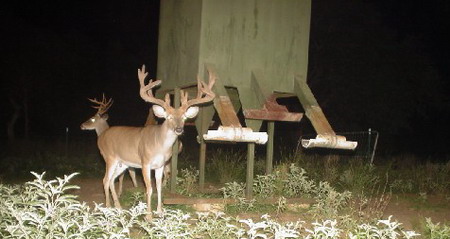Managing the habitat for proper nutrition should be the primary management goal. Supplemental feeding and/or planting of food plots are not a substitute for good habitat management. These practices should only be considered as "supplements" to the native habitat, not as "cure-alls" for low quality and/or poorly managed habitats.
To be most beneficial, supplemental feeding in particular needs to be integrated into an overall deer population and habitat management program that maintains the range in good condition. Feeding programs which provide sufficient additional nutrients to be of value to deer are expensive and take a long term commitment.
Although corn is commonly used as a supplemental feed, it is one of the poorest types of deer feed available and it should not be used as the only source of supplemental feed. Its low protein level (7-10%) is not adequate for the development of bone and muscle, especially at times when the protein levels of native forages is also low. The preferred method is to use a 16% to 20% protein pelleted commercial feed, fed free choice, from feeders distributed at the rate of at least one feeder per 300 acres located within or adjacent to adequate escape cover.
Deer are attracted to corn and it can be mixed with pelleted feed to get deer accustomed to utilizing the feeders. The amount of corn in the mix should gradually be decreased over time. Feeders should be fenced to keep livestock (and feral hogs if present) out but still allow easy access to deer, especially fawns. If net wire is used, the bottom should be raised off the ground (if hogs are not a problem), or there should be low spots on the top, to allow access to smaller deer.
The fenced area should be large enough to minimize creating a confined area that deer may be hesitant to enter. Supplemental feed should be made available throughout the year. Feed consumption will likely vary throughout the year, depending on deer's seasonal nutritional needs and the quality of the native forage. Refer to the TPWD bulletin "Supplemental Feeding" for additional information.
Although corn has limited nutritional value, it can be used as "bait" prior to and during the hunting season to attract and hold deer in an area for more efficient and selective harvest.

Wwhat would be best food to stimulate the growth of deer? As in what type of feed and/or supplement?
I throw table scraps with a lot of bread and vegetables out to the deer. They eat all if it. Will this hurt them?
Pat, feeding whitetail deer fruits and vegetables is fine. Your “supplementation” of their diets should not include a lot of bread though. If you live in an suburban area then I would avoid feeding them altogether.
Would sweet feed be a good food for antler growth?
Sweet feed is often used for horses and mules, but whitetail deer will eat it up! Sweet feed consist of oats, corn, and barley, salt and other minerals mixed with molasses. It smells really good and deer love it, but it cost only slightly less than pelleted rations formulated specifically for deer, which will have protein levels that are at least 16%. In addition, sweet feed can really only be fed using troughs.
I believe if someone is going to feed deer you have to be committed and have a plan. I do a mix with what is called flaked or rolled corn and mix it with peas, turnips and a horse food that is high in protein, then throw in some soy. I keep an eye on the feeding area and make sure that any predators learn what heaven is about.